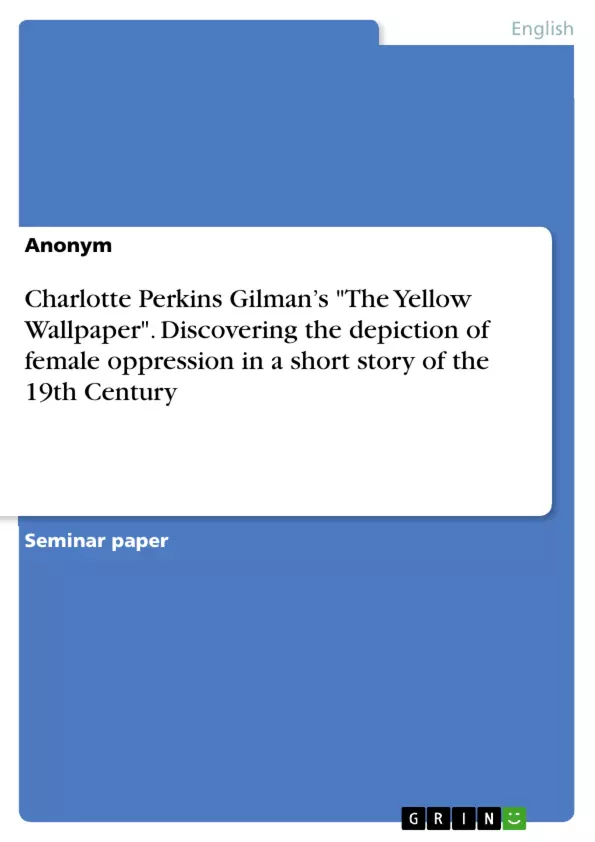In the living years of the author of the short story “The Yellow Wallpaper”, female oppression has always been a great problem. Women were suppressed, treated like an item and had to live under their husband’s rule. As society became increasingly modernized, women, who suffered from a mental illness were prescribed the rest cure, such as the author of the short story in which she reports her experience of the treatment and thus a woman's place in her society.
An interpretation of her story might still be relevant today since gender roles and especially the behavior towards women, remain a widely discussed topic and is not limited to a certain period in time. Therefore, analyzing the short story and the author's attitude towards the medical community of her time will still be worth it.
In order to elaborate on how the oppression of females in the 19th Century is represented in "The Yellow Wallpaper", this paper seeks to analyze the short story from a feminist perspective with a focus on the ways in which gender relations are depicted. Before taking a closer look at the short story, I will shortly examine a woman’s position in the 19th Century, elaborate methods of the medical community performed on Victorian women and explain the rest cure in more detail. Then I will analyze and explain my interpretation of the short story by focusing on essential parts which chart the progression of the narrator’s madness and the cause of it. In the end I will apply the discussed gender relations to the short story and I am going to discuss, if the narrator’s progression of madness, represents her growing rebellion against the prevailing gender relations at that time and whether the used narrative techniques emphasize the visionary break with patriarchy.
Table of Contents
- Introduction
- Women's position in the 19th Century in America
- Women and mental illnesses
- The Rest Cure
- Analysis of "The Yellow Wallpaper"
- Conclusion
Objectives and Key Themes
This paper examines the depiction of female oppression in Charlotte Perkins Gilman's short story "The Yellow Wallpaper" from a feminist perspective. The paper aims to analyze the story's portrayal of gender relations and their impact on the narrator's mental state. To understand the context of the story, the paper will briefly explore the position of women in 19th-century America, focusing on prevailing societal beliefs about femininity, mental illness, and the "rest cure."
- Female oppression in the 19th Century
- The "rest cure" as a treatment for women's mental illnesses
- The connection between female oppression and mental illness
- The use of narrative techniques to depict the narrator's descent into madness
- The narrator's rebellion against patriarchal structures
Chapter Summaries
- Introduction: This chapter introduces the topic of female oppression in the 19th Century and explores its relevance in the context of Charlotte Perkins Gilman's "The Yellow Wallpaper." It outlines the paper's objectives, which include analyzing the short story from a feminist perspective and exploring the connection between gender relations and the narrator's descent into madness.
- Women's position in the 19th Century in America: This chapter explores the social and cultural context of 19th-century America, focusing on the prevailing patriarchal structures and their impact on women's lives. It discusses the societal expectations placed on women, including their confinement to the domestic sphere and the belief in their inherent emotional instability.
- Women and mental illnesses: This chapter examines the prevailing medical theories surrounding women's mental illnesses in the 19th Century. It discusses the belief that women were more prone to mental illness due to their emotional nature and the perceived instability of their life cycles. The chapter also delves into the "rest cure" as a common treatment for women's mental health issues.
Keywords
The key themes of this work are female oppression, the "rest cure," gender relations, Victorian society, mental illness, and feminist literary analysis. The analysis focuses on how societal expectations and patriarchal structures contribute to the narrator's mental decline and her eventual rebellion against these constraints.
- Citar trabajo
- Anonym (Autor), 2021, Charlotte Perkins Gilman’s "The Yellow Wallpaper". Discovering the depiction of female oppression in a short story of the 19th Century, Múnich, GRIN Verlag, https://www.grin.com/document/1417065



